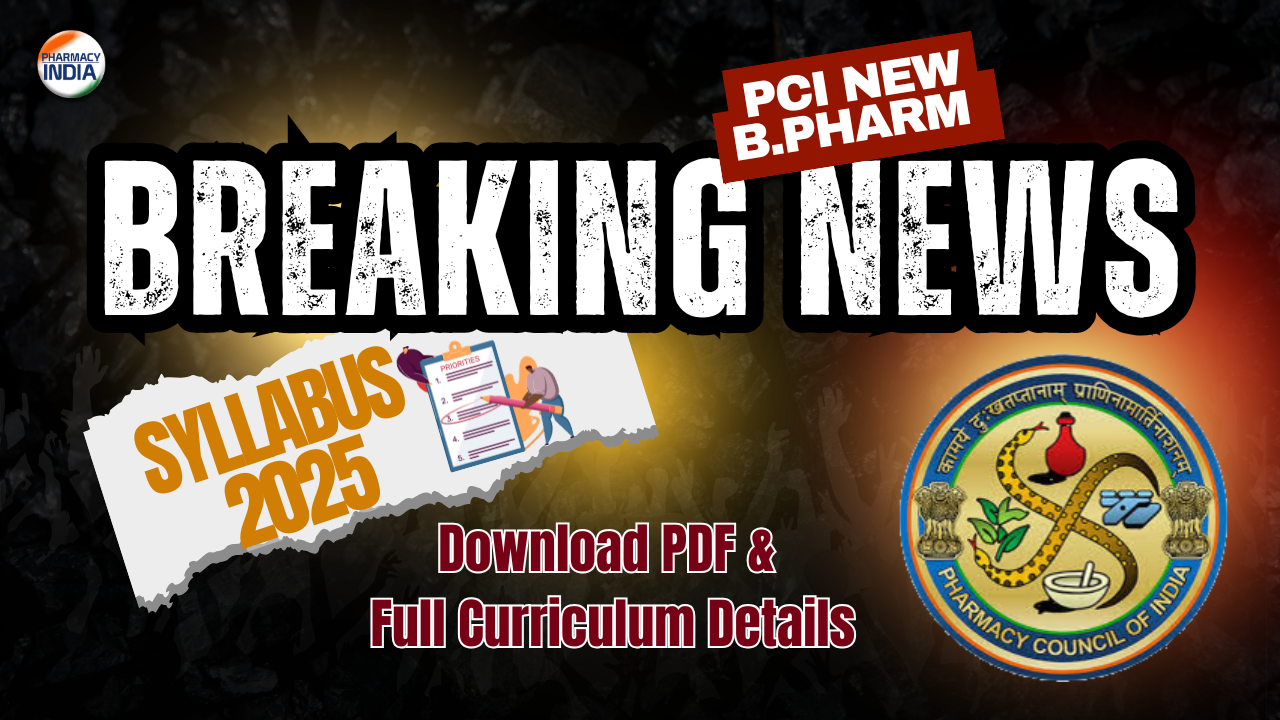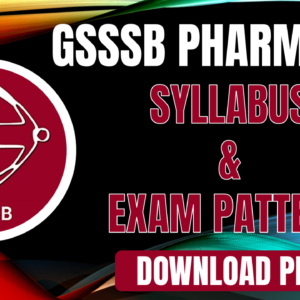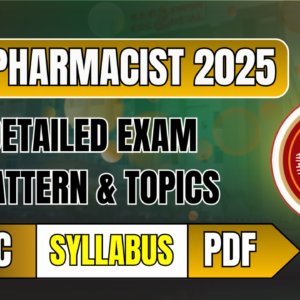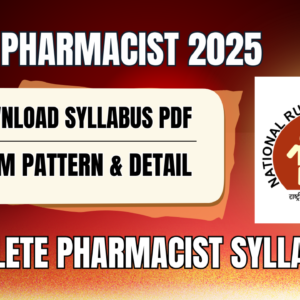New B.Pharm Syllabus Draft by PCI (As per NEP 2020)
A Comprehensive Guide for Pharmacy Students in India
The Pharmacy Council of India (PCI) has released a proposed draft for a new Bachelor of Pharmacy (B.Pharm) syllabus, designed in alignment with the National Education Policy (NEP) 2020. This forward-looking curriculum aims to equip future pharmacists with the skills needed to excel in an evolving healthcare landscape, emphasizing modern concepts like Artificial Intelligence, multidisciplinary learning, and extensive practical training.
Public Notice: Invitation for Comments
The PCI has invited comments and feedback on this proposed B.Pharm syllabus. This is a crucial opportunity for students, academicians, and industry professionals to contribute to the future of pharmacy education in India.
- Reference No: 14-154/2025-PCI
- Date of Notice: 20.8.2025
- Deadline for Comments: Comments must be submitted within one month, up to 20.9.2025.
- Email for Submission: bpharmsyllabus2025@gmail.com
- Important: No comments will be entertained after the deadline of 20.9.2025. The format for submitting comments is provided in Appendix-2 of the official document.
This initiative ensures that the final syllabus is robust, comprehensive, and reflects the collective wisdom of the pharmacy community.
Salient Features of the Proposed B.Pharm Syllabus
The new curriculum is structured to be more dynamic, flexible, and industry-relevant. Here are its key highlights:
- Total Credits: The B.Pharm course will comprise a total of 191 credits.
- Flexibility: Students will have the flexibility to choose from a list of elective courses.
- Experiential Learning: Strong emphasis is placed on hands-on, experiential learning.
- Internships: Two mandatory internships are included, providing real-world exposure to clinical/community and industrial/manufacturing environments.
- Research Project: A mandatory research project at the undergraduate level, spanning two semesters, to foster analytical and problem-solving skills.
- Modern Technologies: The curriculum integrates new-age technologies like Artificial Intelligence (AI) and Python Programming across various pharmaceutical domains.
- Holistic Development: The syllabus includes Majors, Minors, Value-added courses, and Skill Enhancement courses to ensure the all-round development of students.
Curriculum Structure Overview
The 8-semester course is meticulously structured across multiple course categories (MJ – Major, MN – Minor, MD – Multidisciplinary, etc.) to provide a balanced education. The table below gives a high-level overview of the course distribution.
(Scroll the table horizontally to view all semesters)
| Course Category | Semester I | Semester II | Semester III | Semester IV | Semester V | Semester VI | Semester VII | Semester VIII |
|---|---|---|---|---|---|---|---|---|
| MJ-1 (Pharmaceutics) | General Pharmacy (L3) | Physical Pharmaceutics (L3) | Pharmaceutical Dosage Forms (L4) | Herbal Drug Technology (L3) | Biomedical Chemistry (L3) | Pharmaceutical Quality Assurance (L3) | Biostatistics Research methodology (L3) | NDDS and Precision Medicine (L3) |
| MJ-2 (Pharmaceutics Practical) | General Pharmacy (P1) | Physical Pharmaceutics (P1) | Pharmaceutical Dosage Forms (P2) | Herbal Drug Technology (P1) | Biomedical Chemistry (P2) | Pharmaceutical Quality Assurance (P1) | Biostatistics Research methodology (P1) | NDDS and Precision Medicine (P1) |
| MJ-3 (Pharmaceutical Chemistry) | Pharmaceutical Inorganic & Analytical Chemistry (L3) | Biochemistry (L3) | Heterocyclic Compounds & Stereochemistry (L3) | Medicinal Chemistry (L3) | Pharmaceutical Analysis (L3) | — | Modern analytical techniques (L3) | — |
| MJ-4 (Pharm. Chemistry Practical) | Pharm. Inorganic & Analytical Chemistry (P1) | Biochemistry (P1) | Heterocyclic Compounds & Stereochemistry (P2) | Medicinal Chemistry (P1) | Pharmaceutical Analysis (P2) | — | Modern analytical techniques (P1) | — |
| MJ-5 (Pharmacology) | Human Anatomy, Physiology & Pathophysiology I (L4) | Human Anatomy, Physiology & Pathophysiology II (L4) | General Pharmacology (L3) | Systemic Pharmacology & Autacoids (L3) | Systemic Pharmacology & Chemotherapy (L3) | — | Pharmacovigilance (L3) | — |
| MJ-6 (Pharmacology Practical) | HAPP I (P1) | HAPP II (P1) | General Pharmacology (P2) | Systemic Pharmacology & Autacoids (P1) | Systemic Pharmacology & Chemotherapy (P2) | — | Pharmacy Practice (L3) | — |
| MJ-7 (Pharmacognosy) | Introduction To Pharmacognosy (L3) | Pharmacognosy And Phytochemistry (L3) | — | — | Industrial Pharmacognosy (L3) | Advanced Pharmacognosy (L3) | — | — |
| MJ-8 (Pharmacognosy Practical) | Introduction To Pharmacognosy (P1) | Pharmacognosy And Phytochemistry (P1) | — | — | Industrial Pharmacognosy (P2) | Biopharmaceutics & Pharmaco-kinetics (L3) | — | — |
| MJ-9 | — | — | — | — | — | Biopharmaceutics & Pharmaco-kinetics (P1) | — | Industrial Pharmacy & Facility Design (L3) |
| MN-1 (Minor) | — | Pharmaceutical Organic Chemistry (L2) | Pharmaceutical Microbiology (L2) | Pharmaceutical Biotechnology (L2) | — | Intellectual Property Rights (L2) | Regulatory Affairs (L2) | — |
| MN-2 (Minor Practical) | — | Pharmaceutical Organic Chemistry (P1) | Pharmaceutical Microbiology (L1) | Pharmaceutical Biotechnology (P1) | — | — | — | Clinical Pharmacotherapeutics (L2) |
| MN-3 (AI & ML) | AI & Python Programming I (L2) | AI & Python Programming II (L2) | AI in Preformulation (L2) | AI in Drug Design (L2) | AI in Pharmacology (L2) | ML in Pharmacognosy (L2) | Intelligent Manufacturing (L2) | AI in Pharmacy Practice (L2) |
| MN-4 | — | — | Pharmaceutical Engineering (L2) | — | — | — | — | — |
| MD-1 (Multidisciplinary) | Healthcare Psychology (L1) | — | Ethics & Human Values (L1) | Social Pharmacy (L2) | Innovation & Startup (L2) | Jurisprudence (L3) | Cosmetics (L2) | Pharmaceutical Management (L2) |
| MD-2 (Multidisciplinary Practical) | Healthcare Psychology (P1) | — | — | Social Pharmacy (P1) | — | — | — | Pharmaceutical Marketing Skills (L2) |
| AEC (Ability Enhancement) | — | — | Elective 2 (P1) | — | — | Elective 3 (L1) | Elective 6 (L1) | Elective 7 (L2) |
| SEC (Skill Enhancement) | — | Elective 1 (P1) | — | — | — | Elective 4 (P1) | — | — |
| VAC (Value Added) | — | — | — | — | — | Elective 5 (P1) | — | Elective 8 (P1) |
| Internship | — | — | — | Internship (Mandatory) (4 Credits) | — | Internship (Mandatory) (4 Credits) | — | — |
| Research | — | — | — | — | — | — | Research Project (6 Credits) | Research Project (6 Credits) |
| Total Credits | 21 | 23 | 23 | 24 | 24 | 24 | 26 | 24 |
Semester I: Detailed Syllabus
1. General Pharmacy (Theory & Practical)
- Theory Topics: History and evolution of the pharmacy profession, Pharmacopoeias (IP, BP, USP), parts of a Prescription, handling, and potential errors. Detailed study of Pharmaceutical calculations, various Dosage forms (solid, liquid, semi-solid), and the role of Active Pharmaceutical Ingredients (APIs) and excipients in formulation.
- Practical Topics: Hands-on practice with pharmaceutical calculations (allegation, dilution). Preparation and evaluation of simple dosage forms like solutions, syrups, elixirs, emulsions, powders, granules, and suppositories according to pharmacopoeial standards.
2. Pharmaceutical Inorganic and Analytical Chemistry (Theory & Practical)
- Theory Topics: Sources and types of impurities in pharmaceutical substances, principles and procedures for limit tests. Introduction to fundamental analytical techniques. Detailed study of acids, bases, and buffers, major physiological ions, gastrointestinal agents (antacids, cathartics), and radiopharmaceuticals. Comprehensive coverage of titrimetric methods of analysis including acid-base, redox, and complexometric titrations.
- Practical Topics: Performing official limit tests for chloride, sulphate, and iron. Preparation of inorganic pharmaceuticals like potash alum. Assay of inorganic compounds such as ammonium chloride, ferrous sulphate, and boric acid using titrimetric methods.
3. Human Anatomy, Physiology and Pathophysiology – I (Theory & Practical)
- Theory Topics: Introduction to the human body, exploring the cellular and tissue levels of organization. In-depth study of the Integumentary system (skin), Skeletal system (bones, joints), Body fluids and blood (composition, blood groups, coagulation), the Lymphatic system, Peripheral nervous system, and Special senses (eye and ear). Basic principles of cell injury and adaptation.
- Practical Topics: Introduction to the compound microscope. Microscopic study of various tissues (epithelial, connective, muscular). Study of axial and appendicular bones. Key hematology experiments including WBC/RBC enumeration, differential count, blood grouping, and estimation of hemoglobin content.
4. Introduction to Pharmacognosy (Theory & Practical)
- Theory Topics: Definition, history, present status, and scope of Pharmacognosy. Sources of drugs (Plants, Animals, Marine, etc.). Detailed classification of crude drugs (alphabetical, morphological, chemical). Introduction to primary and secondary plant metabolites. Methods for quality control, cultivation, collection, and processing of crude drugs.
- Practical Topics: Microscopic studies of key crude drugs like Clove, Fennel, Cinnamon, and Ginger to identify their characteristic features. Performing chemical tests for the identification of various phytoconstituents such as carbohydrates, proteins, alkaloids, glycosides, and tannins.
5. Healthcare Psychology and Communication Skills (Theory & Practical)
- Theory Topics: Introduction to psychology and its relevance in healthcare. Study of developmental and behavioral psychology, foundations of health communication (models, barriers, techniques), and professional communication skills for healthcare settings. Introduction to behavioral interventions and mental health promotion.
- Practical Topics: Engaging in role-plays for patient counseling scenarios (e.g., chronic illness, breaking bad news). Analysis of case studies on mental health and miscommunication errors. Peer-to-peer practice sessions on reflective listening and team communication.
6. AI & Python Programming for Pharmacy – I (Theory)
- Theory Topics: Foundations of Artificial Intelligence (AI), including its history and major approaches. Introduction to Machine-Learning (ML) essentials (supervised, unsupervised, reinforcement learning) and core algorithms (Naive Bayes, KNN, regression). Exploring industrial applications and research avenues of AI/ML in the pharmaceutical sector. Fundamentals of Python programming: setup, language basics, data types, and syntax.
Semester II: Detailed Syllabus
1. Physical Pharmaceutics (Theory & Practical)
- Theory Topics: Detailed study of solubility and distribution phenomena, interfacial phenomena (surface tension, adsorption), properties of colloidal and coarse dispersions (suspensions, emulsions), including DLVO theory and theories of emulsification. Introduction to rheology (Newtonian and non-Newtonian systems) and micromeritics (particle size, shape, and flow properties).
- Practical Topics: Experiments to determine surface tension, viscosity, critical micellar concentration (CMC) of surfactants, sedimentation volume of suspensions, and micromeritic properties like particle size, bulk density, and angle of repose.
2. Pharmaceutical Organic Chemistry (Theory & Practical)
- Theory Topics: Chemistry of aliphatic hydrocarbons (alkanes, alkenes, dienes), mechanisms of substitution and addition reactions. Chemistry of alkyl halides (SN1, SN2, E1, E2 reactions). In-depth study of benzene and its derivatives (aromaticity, electrophilic substitution) and carbonyl compounds (aldehydes and ketones, nucleophilic addition reactions).
- Practical Topics: Systematic qualitative analysis to identify unknown organic compounds from various chemical classes. Preparation of simple organic compounds and their derivatives. Purification of compounds using crystallization.
3. Human Anatomy, Physiology and Pathophysiology – II (Theory & Practical)
- Theory Topics: In-depth study of the Nervous system (central and peripheral), Gastrointestinal system (digestion, absorption), Respiratory system (mechanism of breathing), Urinary system (urine formation), Endocrine system (hormones and their functions), and Reproductive system. Pathophysiology of major disorders like epilepsy, peptic ulcer, asthma, and diabetes.
- Practical Topics: Study of various organ systems using models and charts. Demonstration of general neurological examination and reflex activity. Experiments related to special senses and measurement of tidal volume and vital capacity.
4. Pharmacognosy and Phytochemistry (Theory & Practical)
- Theory Topics: Study of metabolic pathways (Shikimic acid, Acetate) for the biosynthesis of secondary metabolites. Detailed pharmacognosy of drugs containing primary metabolites (carbohydrates, proteins, lipids) and secondary metabolites (alkaloids like Vinca, glycosides like Senna, tannins like Catechu). Modern methods of extraction and isolation of phytoconstituents.
- Practical Topics: Identification of crude drugs via specific chemical tests (e.g., for Asafoetida, Aloes). Quantitative microscopy for determining stomatal number, vein-islet number, and fiber length. Spectrophotometric and gravimetric determination of phytoconstituents.
5. Biochemistry (Theory & Practical)
- Theory Topics: Enzymology (kinetics, inhibition, regulation). Bioenergetics and biological oxidation (Electron Transport Chain). Detailed metabolism pathways for carbohydrates, lipids, amino acids, and nucleic acids. Clinical significance of metabolic disorders and organ function tests.
- Practical Topics: Qualitative analysis of carbohydrates and proteins. Quantitative estimation of clinically important biomolecules like blood glucose, total cholesterol, urea, creatinine, and serum proteins. Study of enzymatic activity.
6. AI & Python Programming for Pharmacy – II (Theory)
- Theory Topics: Application of linear algebra including matrices, determinants, eigenvalues, and eigenvectors in AI. Fundamentals of calculus (differentiation, integration, differential equations) and their application in pharmacokinetics. Understanding matrix multiplication in neural networks. Exploring AI applications in automated dispensing, inventory control, and clinical decision support systems (CDSS).
Important Links
| Resource | Link |
|---|---|
| Download Official Draft Syllabus PDF | Click Here to Download |
| Pharmacy Council of India (PCI) Official Website | Visit PCI Website |
Note: The detailed syllabus for Semesters III to VIII will be updated following this comprehensive format. This new curriculum clearly indicates a major shift towards integrating modern technology and research into undergraduate pharmacy education, preparing students for the future of healthcare.
MORE :Pharmacist Recruitment Mehsana 2025: 07 Posts at District Health Society (NHM) – Apply Online
<<<<<<<<<<<<JOIN US>>>>>>>>>>>>>>>>
| Subscribe our PHARMACY INDIA YouTube Channel for more Pharma Updates | Click Here |
| Follow us on Instagram | Click Here |
| Download PHARMACY INDIA MOBILE APP from Google Play Store | Click Here |
| Follow us on LinkedIn | Click Here |







One thought on “PCI New B.Pharm Syllabus 2025 (NEP 2020): Download PDF & Full Curriculum Details”